If you want juiciness, tastiness, and nutrition in one fruit, apples are your best bet.
Apples are one of the most ubiquitous fruits in the world with around 7500 varieties.
Of the 7500 varieties, around a third (2500 varieties) are cultivated all over the US. But interestingly, only the Crabapple is indigenous to North America.
Apples aren’t just for snacks. They can be used in baking, cooking, and making cider and oils from apples can also be extracted and used for different flavoring purposes.
Don’t be discouraged, we aren’t going to cover all 7500 apple varieties in this article. But if you want to learn about a few of them, we’ll cover some information about their color, taste, and different uses.
Table of Contents
Types of Apples
1. Fuji Apple

- Color: Red (sometimes with yellow-green highlights)
- Sweet or Tart: Sweet
- Common Uses: Apple sauce, salad, apple pie, and beverages
Fuji Apple has its origins in Fujisaki, Japan. It was created toward the end of the 1930s, and it currently finds use as a flavor enhancer.
At first, the Fuji Apple typically has a mild flavor. But as it gets older, the flavor becomes stronger.
2. Honeycrisp Apple
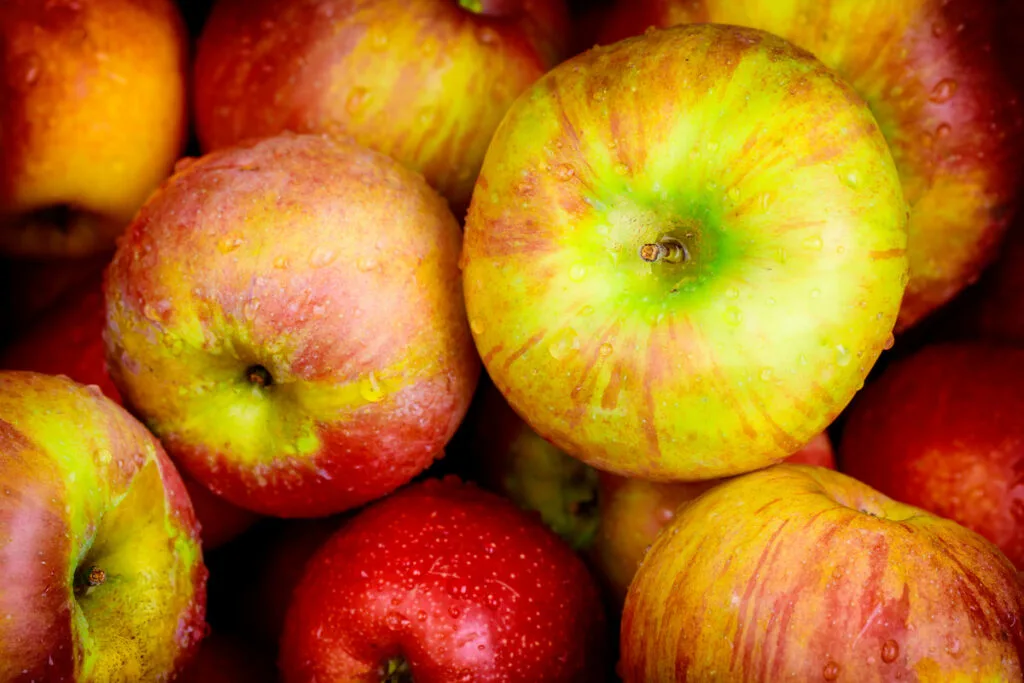
- Color: Red
- Sweet or Tart: Subtly tart
- Common Uses: Cider, sauces, and fruit salad
The Honeycrisp Apple is remarkable for its ability to resist oxidization and maintain its shape. Hence, you’ll find it in various desserts and dishes.
The Honeycrisp Apple was created by the University of Minnesota around the 1960s.
3. Granny Smith
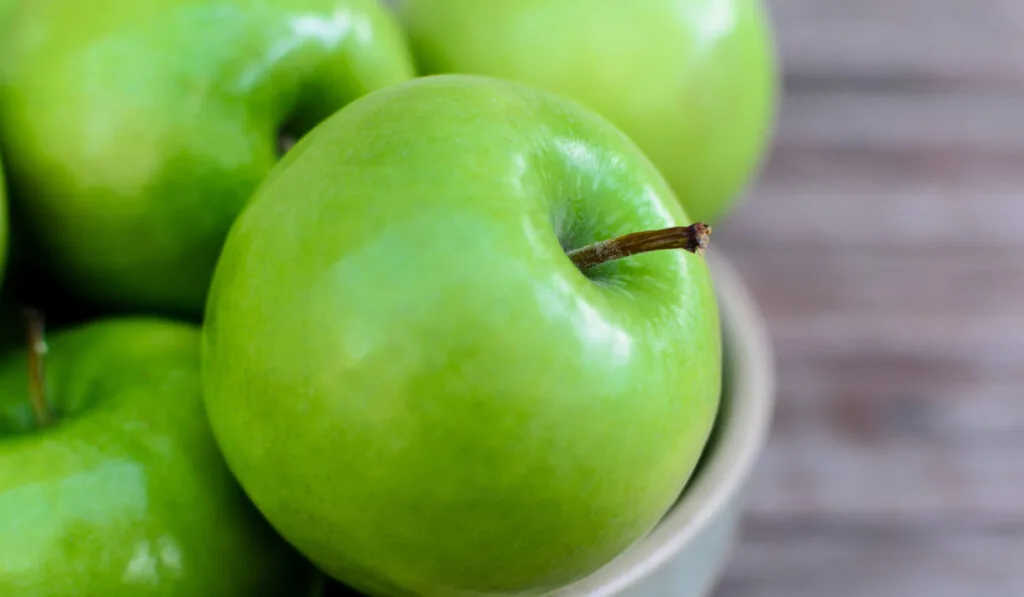
- Color: Light Green
- Sweet or Tart: Bold and acidic tart
- Common Uses: Juices, apple pies, and dipping sauce
Granny Smith is one of the most readily available green apples.
It has its origins in Australia but is now grown in various other countries. Granny Smith is an all-purpose apple, and it is very crisp too.
4. Twenty Ounce Pippin
- Color: Green or Bright-Yellow with red striations
- Sweet or Tart: Tart
- Common Uses: Dried apple chips, applesauce, and apple pie
The Twenty Ounce Pippin might not have a prominent taste, but as indicated by its name, it is one of the biggest green apples.
5. Newtown Pippin Heirloom Apple
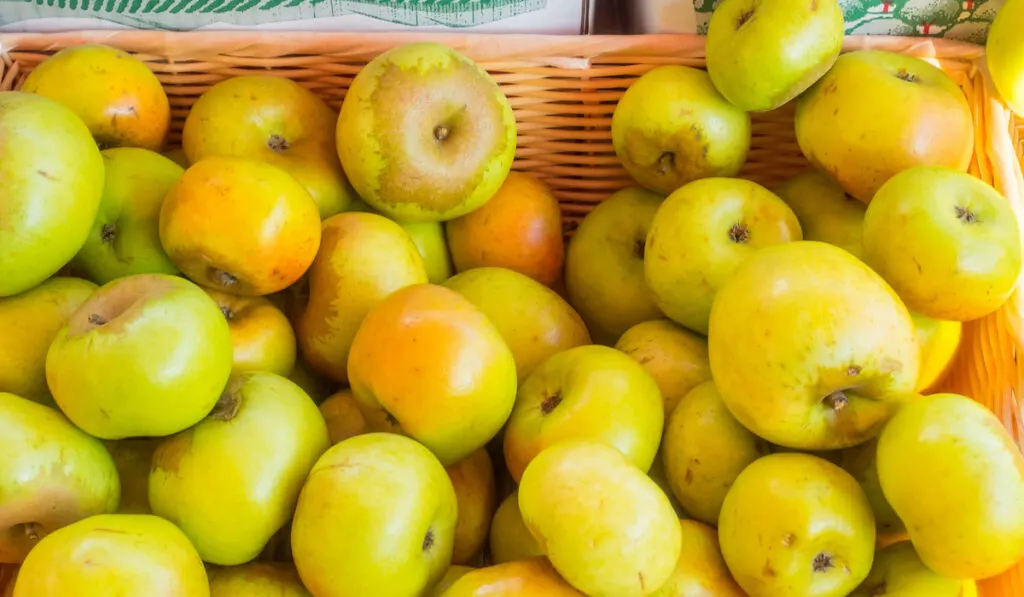
- Color: Green but becomes yellow upon storage
- Sweet or Tart: Tart
- Common Uses: Snacking, crisps, apple pies, and desserts
The Newtown Pippin Heirloom Apple is popular in New York City. It has a rich zest and gets sweeter while in storage.
6. Crispin Green-Yellow Japanese Apple

- Color: Greenish-Yellow
- Sweet or Tart: Slightly tart
- Common Uses: Snacking, cooking, or baking
The Crispin Green-Yellow Japanese Apple is a progeny of the Golden Delicious Apple although it is crunchier and crispier than its parent variety.
7. Antonovka
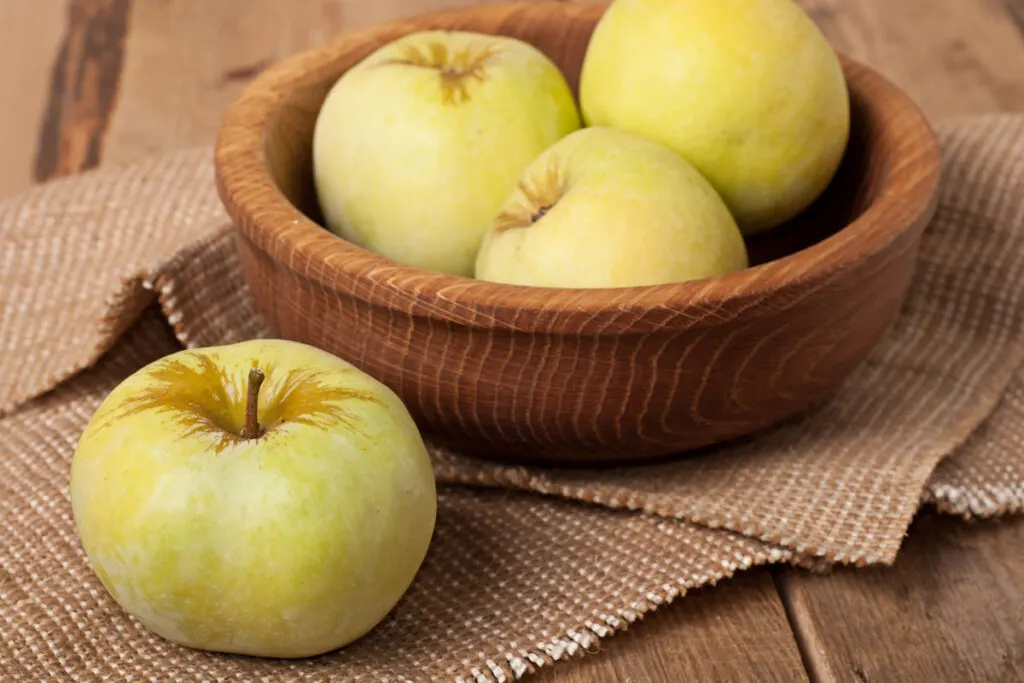
- Color: Pale Green
- Sweet or Tart: Tart yet sweet
- Common Uses: Snacking or cooking
The Antonovka has its roots in Russia, and it was first discovered in the earlier parts of the 1800s.
This apple is hardier than most other varieties. So, it thrives even in cold climates.
8. Rhode Island Greening
- Color: Green to Yellow
- Sweet or Tart: Citrusy tart
- Common Uses: Juices, apple pies, and apple sauce
The Rhode Island Greening is thought to be a progeny of the Granny Smith. But its flavor is more intricate than that of its parent variety.
The Rhode Island Greening typically becomes juicier as the years go by. It is common in orchards and specialty markets around the US east coast.
9. Pound Sweet
- Color: Bright Green
- Sweet or Tart: Sweet
- Common Uses: Apple butter
The Pound Sweet Apple is most common in the US. They are large and look a lot like Granny Smith Apple.
The Pound Sweet Apple is not common in commercial orchards. But if you want one, you could check a farmer’s market or a local orchard.
10. Shamrock Apple
- Color: Light Green
- Sweet or Tart: Tart
- Common Uses: Snacking or applesauce
Shamrock Apples were developed by crossing Golden Delicious Apples with Red-Green McIntosh Apples.
If you want Shamrock Apples, you may have to hold on till between September and November when they are harvested.
Shamrock Apples are hard to store so they are usually limited in stock.
11. Grenadier
- Color: Pale Green that becomes Yellowish-Green
- Sweet or Tart: Very tart
- Common Uses: Apple sauce, apple butter, and jam (may not do well in apple pies)
Grenadier Apple originated in Buckinghamshire, England, around 1862. It is mainly used for cooking and comes with tender light-green flesh.
12. Lodi Apple
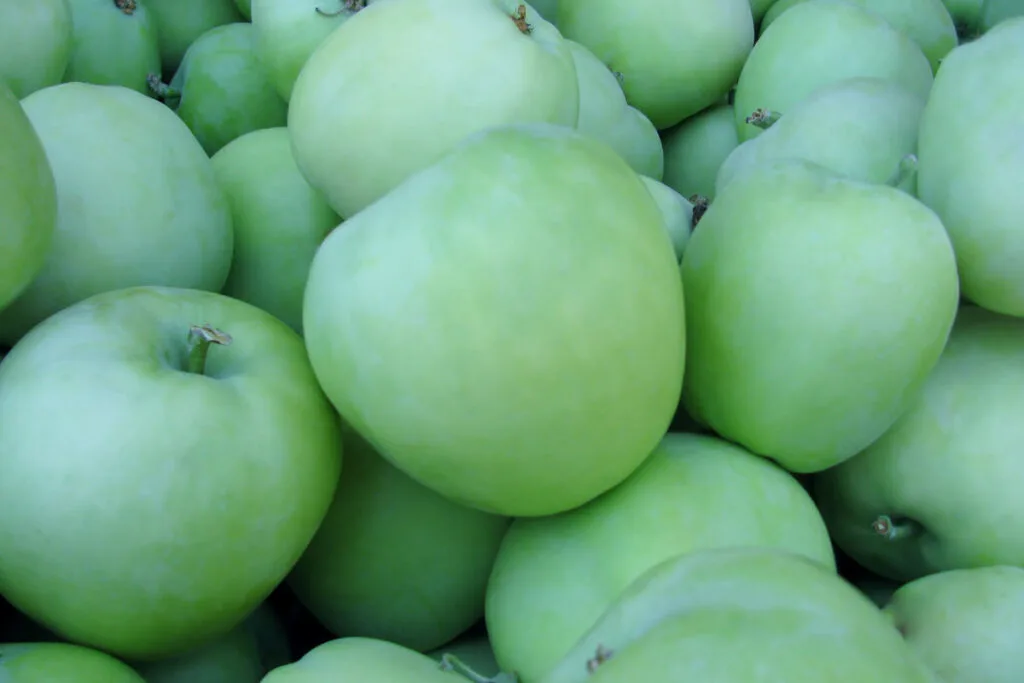
- Color: Pale Green
- Sweet or Tart: Tart
- Common Uses: Applesauce and baking
Lodi Apples were created from the New York Yellow Transparent Apples.
They are typically harvested in early fall, which is earlier than many other varieties.
13. Tolman Sweet Green Apple
- Color: Butter Yellow or Green
- Sweet or Tart: Sweet
- Common Uses: Snacking, apple sauce, and baking
The Tolman Sweet Green Apple was first seen in Massachusetts almost 200 years ago. This type of apple is best eaten when fresh.
It is not available everywhere, like most other types. So, if you want a Tolman Sweet Green Apple, you may have to check specialty orchards between late September and November.
14. Calville Blanc d’Hiver French Green Apple
- Color: Pale Green
- Sweet or Tart: Tart
- Common Uses: Apple pie and tarts
Calville Blanc d’Hiver is a cultivar with French Origins. It is one of the top choices of French chefs, and its popularity is growing as an ingredient in apple pies in the US.
15. Ashmead’s Kernel Apple
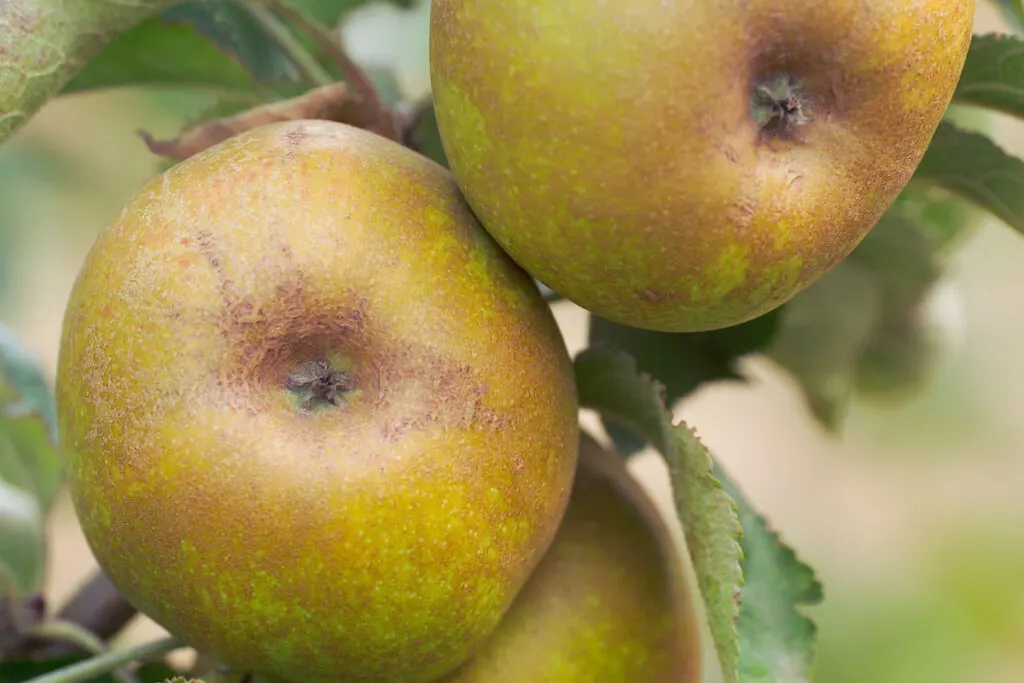
- Color: Greenish-Yellow
- Sweet or Tart: Sweet and tart
- Common Uses: Snacking, cider, or apple juice.
Ashmead’s Kernel Apple originated in Gloucester, England, in the 18th century.
It is an heirloom apple that is typically sour when plucked. But following storage for a month or two, they become tasty.
16. Duke of Devonshire
- Color: A lightly-russeted, dull-green color that becomes yellow as the apple becomes ripe
- Sweet or Tart: Sweet with a little hint of tartness
- Common Uses: Cider and apple juice
The Duke of Devonshire is a russeted apple with origins in Cumbria, UK.
It is a fruity-type apple that shares some similarities with Ashmead’s Kernel Apple. In fact, it is thought that this apple was derived from Ashmead’s Kernel Apple.
17. Grimes Golden

- Color: Greenish-Yellow
- Sweet or Tart: Sweet
- Common Uses: Cooking and making desserts.
The Grimes Golden apple originated from Thomas Grimes’ farm in Wellsburg, West Virginia. It is also a favorite amongst apple connoisseurs.
18. Golden Noble
- Color: Yellow
- Sweet or Tart: A balance of tart and sweet
- Common Uses: Cooking and apple sauce.
Golden Noble is a cooking apple from England.
It was discovered in an orchard in Norfolk, England. After its discovery, the Golden Noble apple was submitted to the Horticultural Society of London around 1820.
19. Manks Codlin Green Apple
- Color: Bright-Green with some red flush
- Sweet or Tart: Tart
- Common Uses: Pies and sauces
The Manks Codlin Green Apple was cultivated for the first time in the Isle of Man in 1815.
This apple type is hardy and has yellowish-green flesh.
Although the peel is colored bright-green, sometimes patches of red flush appear in the fall when the temperature falls.
20. Envy Apple
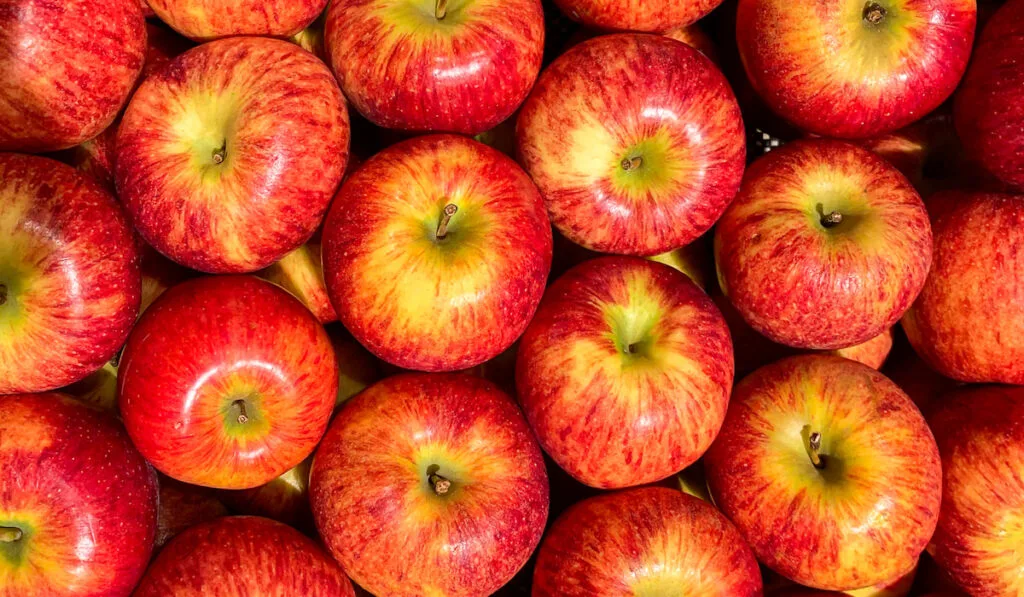
- Color: Ruby-Red with traces of green
- Sweet or Tart: Sweet
- Common Uses: Snacking, salads and baking
Envy Apple was created in New Zealand between 2008 and 2009.
It was formed from crossing the Royal Gala Apple with the Braeburn Apple and is noted for being tough and crunchy.
21. Gala Apple
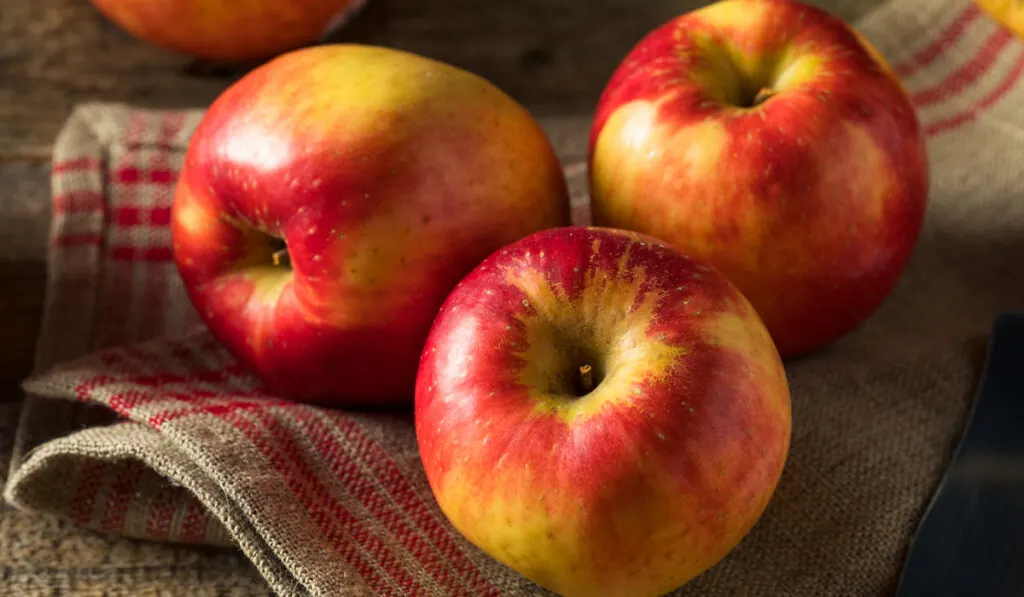
- Color: Mottled Orange
- Sweet or Tart: Sweet
- Common Uses: Cooking and baking
Gala Apples were also developed in New Zealand.
They were formed from crossing Kidd’s Orange Red Apples with Golden Delicious Apples around 1934. The orchardist credited with the discovery of this apple type is J.H Kidd.
The flavor in Gala Apples is not so intense. But they still find applications in baking and cooking.
22. Baldwin Apple
- Color: Crimson Red with some green hints
- Sweet or Tart: Sweet-tart
- Common Uses: Snacking and cooking
Baldwin Apple is an heirloom apple that originated from Massachusetts, USA. It came to be through a wild seedling that was on the farm of John Ball.
23. Cox’s Orange Pippin
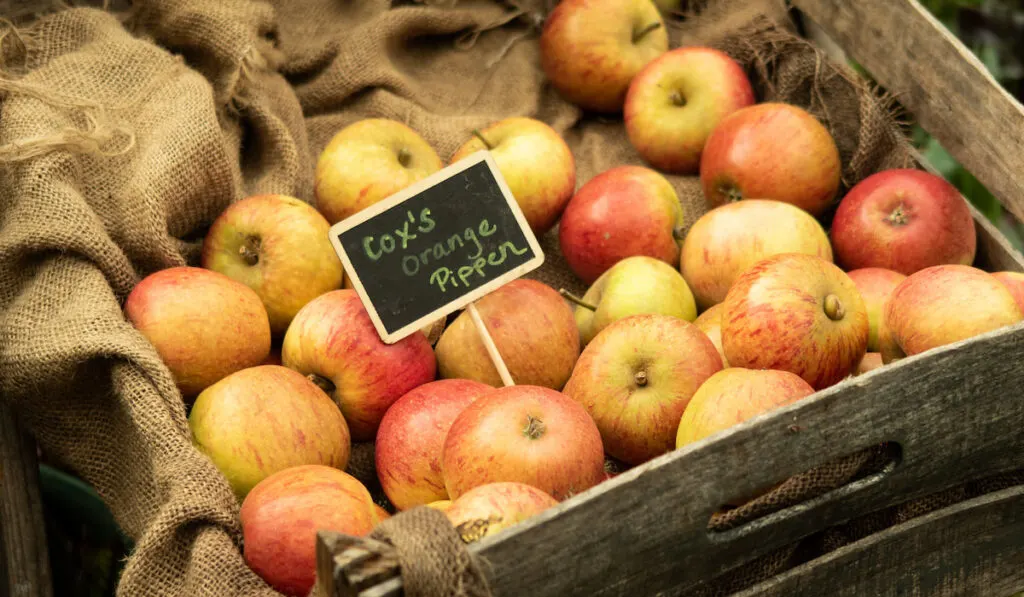
- Color: Orange-Red
- Sweet or Tart: Sweet
- Common Uses: Juice, cider, and baking as well as use in mincemeat and chutneys
Cox’s Orange Pippin is also called Cox. It is thought that this type of apple might be a progeny of the Ribston Pippin.
24. Cortland Apple
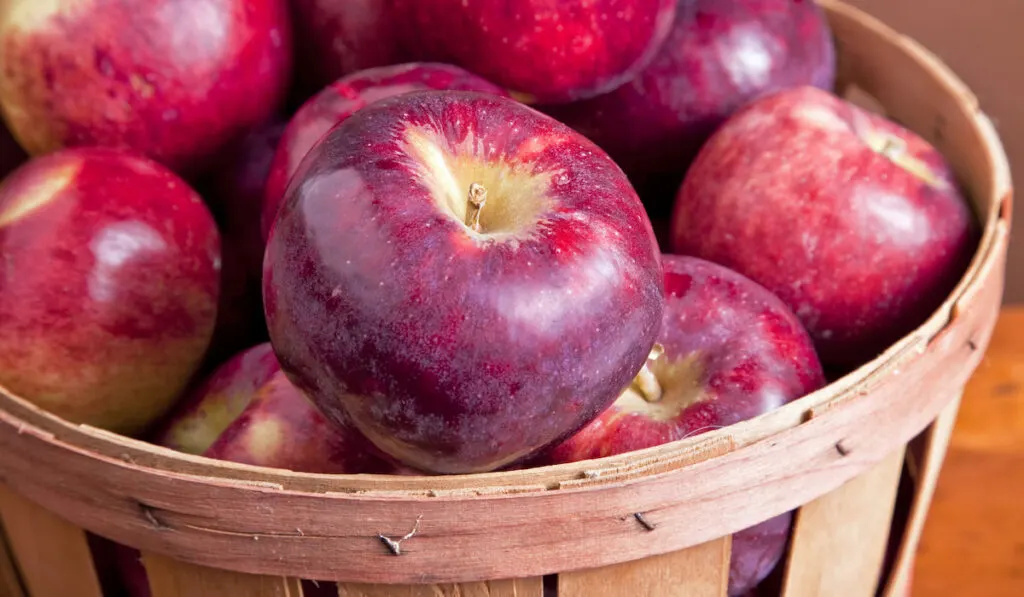
- Color: Bright-Red with green blushes
- Sweet or Tart: Sweet-tart
- Common Uses: Cheeses and dips, baking, quiches, cobblers, applesauce, cider, and even soups
Cortland Apple is named after Cortland County, New York – the first place it was cultivated.
It is one of the most apple cultivars, as evident in the uses above.
25. Macoun Apple

- Color: Red with striated green
- Sweet or Tart: Sweet but slightly tart
- Common Uses: Snacking, apple pie, salad, and applesauce
Macoun Apples were created by crossing Jersey Blacks and McIntosh Apples.
They were discovered in Geneva, New York, in the early 1920s and named after W.T. Macoun.
26. Empire Apple

- Color: Red with green blush and white striations
- Sweet or Tart: Sweet and tart
- Common Uses: Snacking, salads, coleslaw, baking, roasting, and sauteeing
The Empire Apple is a cross between Red Delicious and McIntosh. True to this crossing, the Empire Apple’s flavor is a combination of those of the Red Delicious and McIntosh.
This apple cultivar was created in New York, USA, at Cornell University around the 1940s.
27. Hyslop Crabapple
- Color: Red or Purple
- Sweet or Tart: Tart
- Common Uses: Pickles, jellies, applesauce, and hard cider due to containing tannins
The Hyslop Crabapple came to be in the early 1800s. However, its exact roots remain unknown.
It was discovered by the Hyslop family and may also be called Hyslop Crab or Hislop.
28. McIntosh Apple

- Color: Red and Green
- Sweet or Tart: Sweet-tart
- Common Uses: Purees, pies, soups, pizzas, and tarts
Interestingly, MacIntosh Apple is the reason Apple computers got the name Mac or MacIntosh.
McIntosh Apples were discovered in Ontario, Canada, by John McIntosh in the spring of 1811.
29. Pazazz Apple
- Color: Green to yellow with red stripes
- Sweet or Tart: Sweet yet subtly tart
- Common Uses: Salads, poaching, roasting, and baking
Pazazz Apple is a cultivar with a unique flavor. It originated from Minnesota, USA, and it was created through open pollination.
It is a progeny of the Honeycrisp Apple, but its pollen parent is not known.
30. Spartan Apple
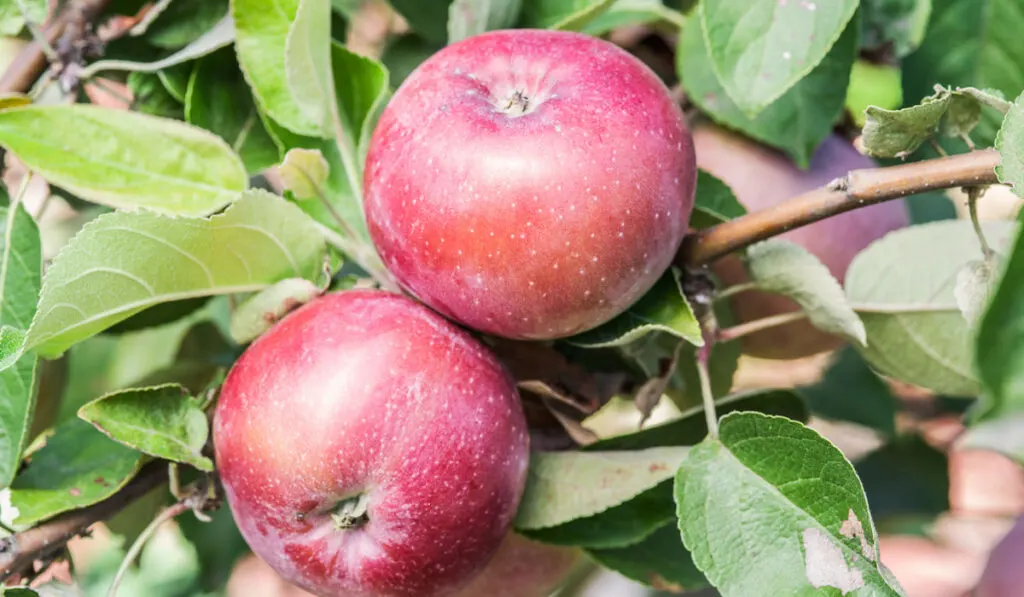
- Color: Red to Dark-Purple
- Sweet or Tart: Sweet-tart
- Common Uses: Cooking and baking (crisps, pies, fritters, chutney, and cheese puffs)
The Spartan Apple originated from British Columbia, Canada.
It was created from the McIntosh Apple by Dr. R.C. Palmer in 1936. As expected, it has a similar appearance and flavor to the McIntosh.
31. Jazz Apple

- Color: Rosy Red
- Sweet or Tart: Mildy sweet and tart with a bit of spice
- Common Uses: Crisps, cakes, muffins, tarts, apple pies, gallettes, and bread
Jazz Apples were created in New Zealand in 1985 through a cross between Royal Gala and Braeburn. This apple is a Scifresh cultivar and a trademarked brand.
32. Red Delicious Apple
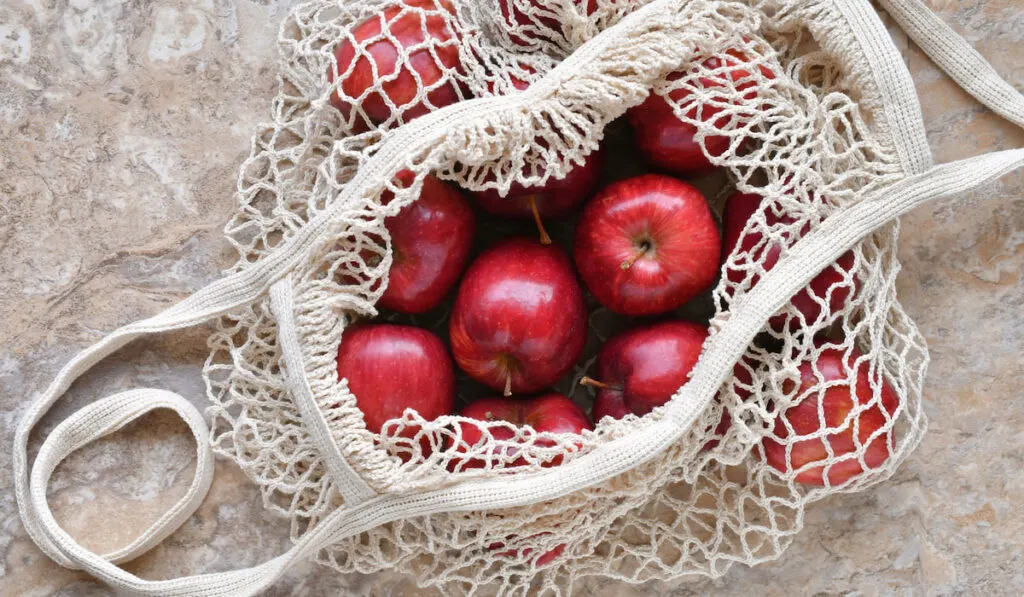
- Color: Dark-Crimson Red
- Sweet or Tart: Sweet
- Common Uses: Salads, burgers, quesadillas, and sandwiches
The Red Delicious Apple originated from Peru, Iowa, on Jesse Hiatt’s farm. It was discovered in 1985 through chance seeding.
Jesse Hiatt tried to cut down the Red Delicious Apple tree three times because he thought it was a weed before he finally conceded and let it thrive.
The flesh of the Red Delicious Apple does not maintain its form when cooked. Thus, it is mainly used in fresh preparations.
33. Cameo Apple
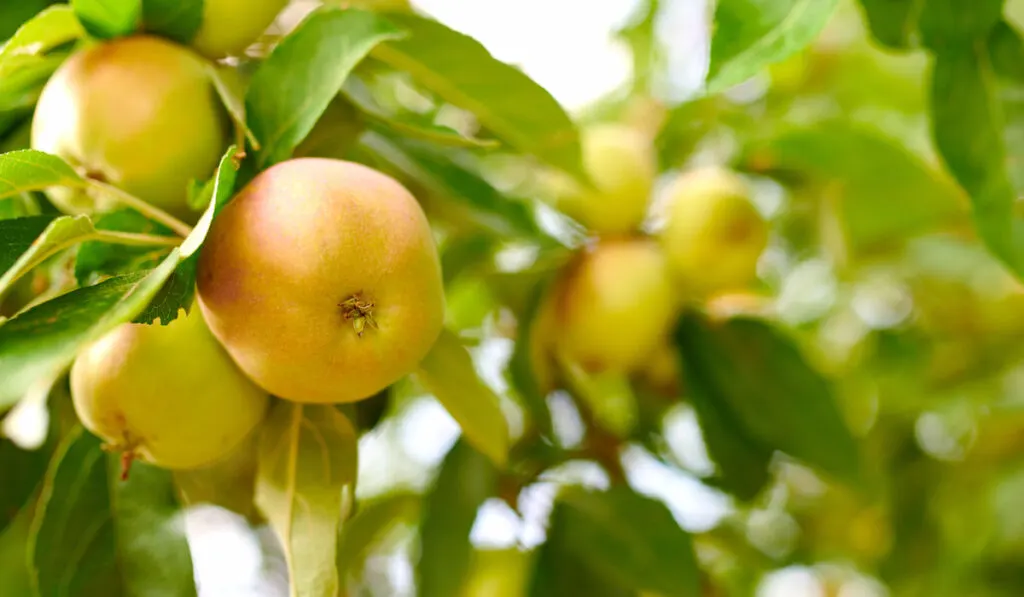
- Color: Creamy-Orange with red stripes
- Sweet or Tart: Sweet and tart
- Common Uses: Fresh preparations such as salads and sandwiches
The Cameo Apple stemmed from a chance seedling and was discovered by the Caudle family in 1987 in Washington.
The parentage of this cultivar is not known for sure. But it is thought to have come from Red Delicious and Golden Delicious.
34. Braeburn Apple
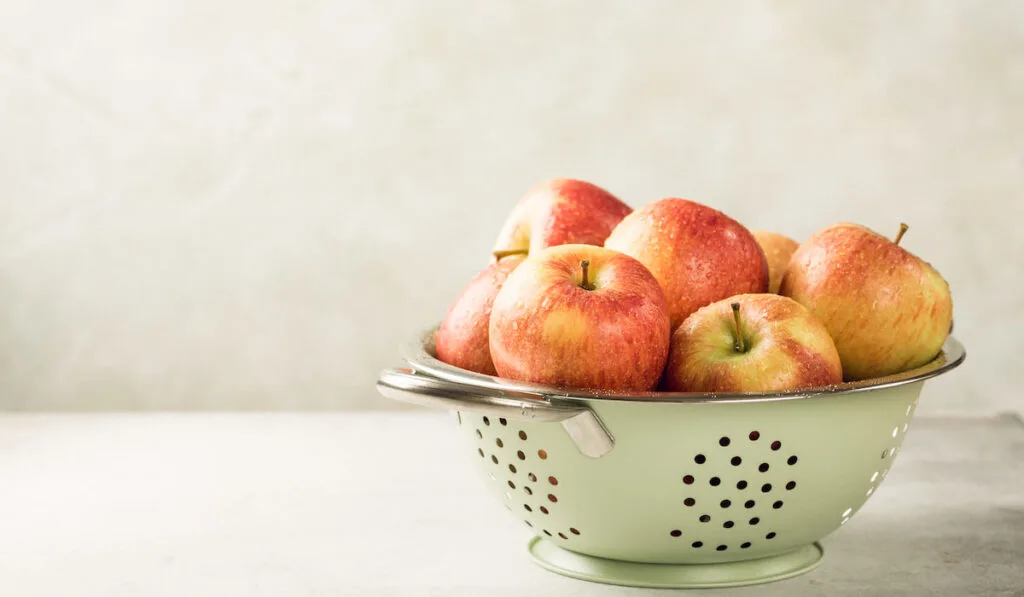
- Color: Red streaks on a green/yellow background
- Sweet or Tart: Sweet and tart
- Common Uses: Snacking, fresh preparations, baking, and roasting
Braeburn Apple originated from Nelson, New Zealand. It was discovered in the 1950s and was first grown commercially in the Braeburn Orchard.
35. Gravenstein Apple

- Color: Green to Yellow background with red striping
- Sweet or Tart: Sweet-tart
- Common Uses: Cider and applesauce
Gravenstein Apples were discovered as far back as 1797. The trees of this apple cultivar are often large, and they come with thick leaves.
Gravenstein Apple is hardy, but perhaps only by European standards. Extreme weather conditions in North America might affect it significantly.
36. Liberty Apple
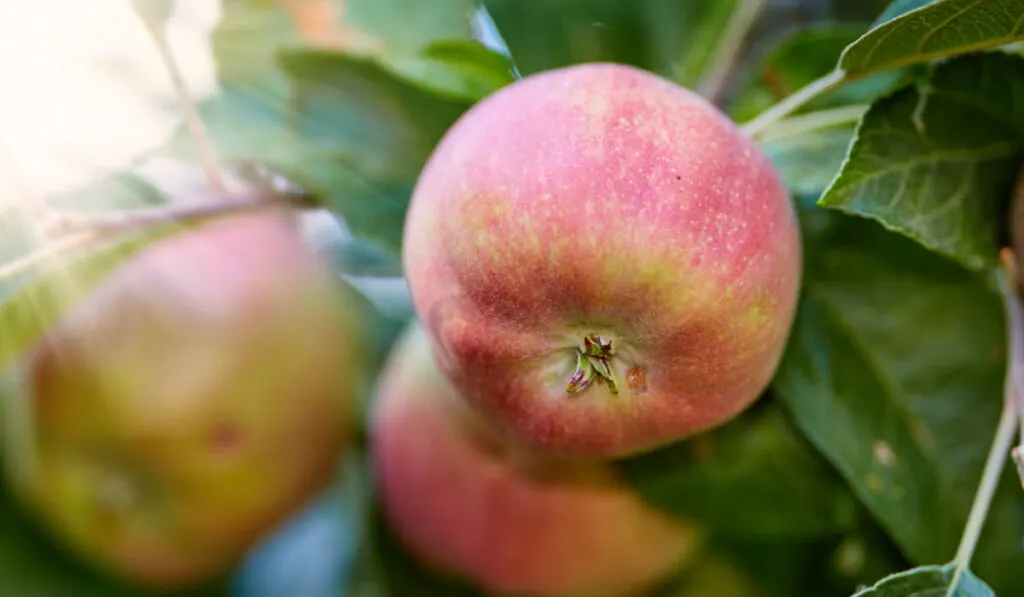
- Color: Dark-Red with a yellow undertone
- Sweet or Tart: Sweet with a tart finish
- Common Uses: Desserts
The Liberty Apple originated from New York, USA. It was developed by the New York State Agricultural Experiment Station in a bid to create a McIntosh-esque apple.
A crossing between Malus Floribunda and McIntosh produced what is now known as the Liberty Apple.
37. Lady Alice Apple
- Color: Creamy-Yellow background with pinkish/red blush
- Sweet or Tart: Sweet with a slight tartness
- Common Uses: Snacking, cooking, or baking
Around the 1970s in Washington, Lady Alice Apple was discovered. Don Emmons, a farmer, was credited with the discovery of this cultivar.
Lady Alices are juicy, crisp, firm-fleshed, and sweet with a tart aftertaste.
38. Winesap Apple
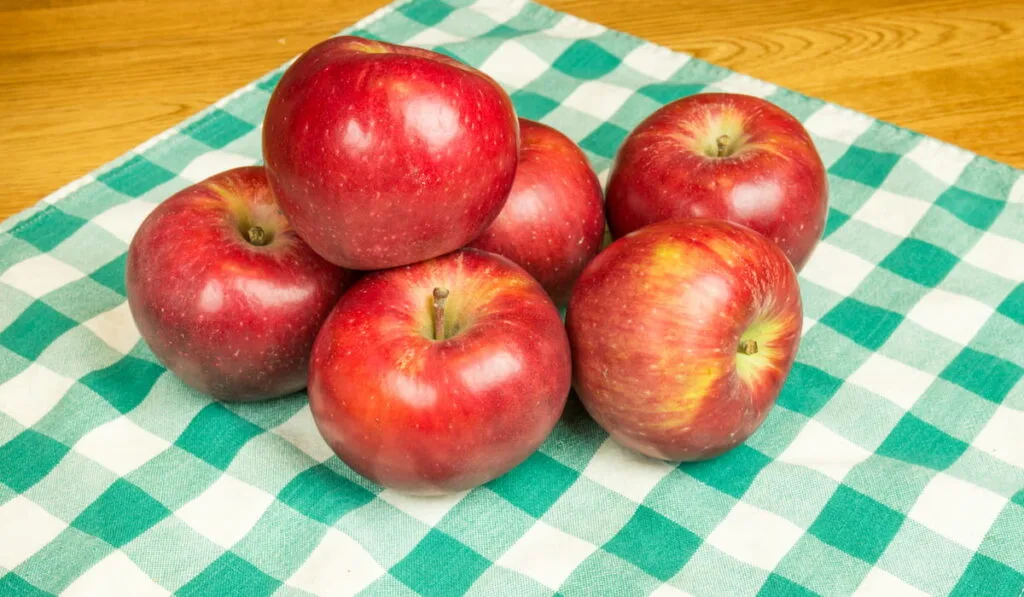
- Color: Dark-Red with a creamy-yellow undertone
- Sweet or Tart: Sweet-tart
- Common Uses: Snacking, cider, apple pies, juice, and apple butter
The exact origin of the Winesap Apples is not known. But it is thought that they have been around since the 18th century.
The Winesap Apple is not quite as sweet as many other red apples. But its tartness makes it a good option for making ciders.
39. Kiku
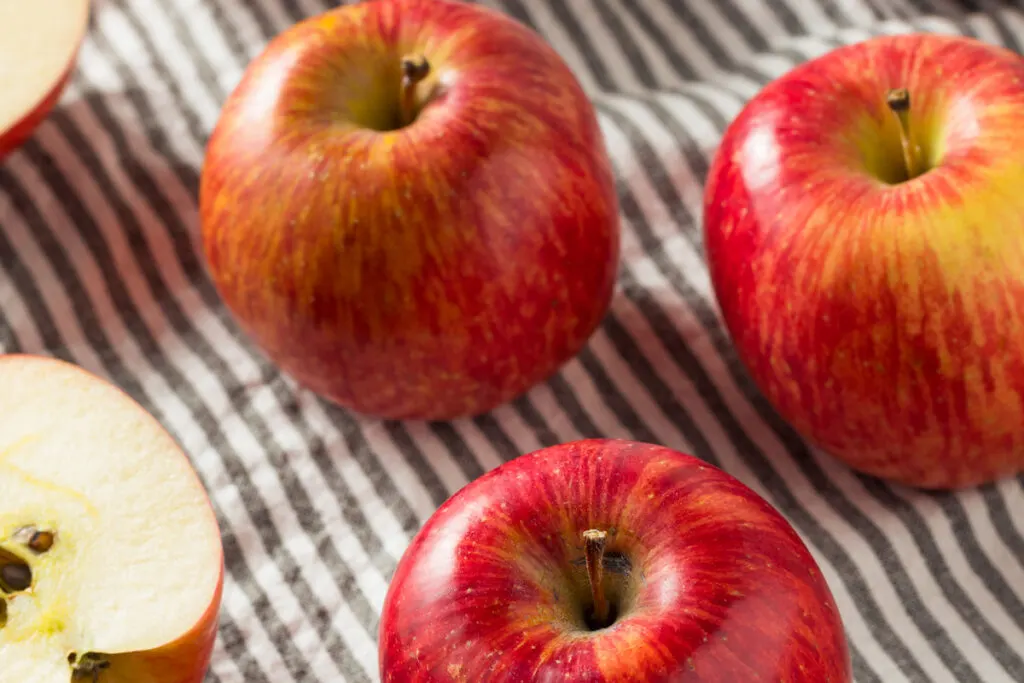
- Color: Ruby-Red with yellow stripes
- Sweet or Tart: Sweet
- Common Uses: Pies, applesauce, sandwiches, salads, and tarts
Kiku Apple maintains its form when cooked. So, it finds various applications in cooking.
It originated from Japan in a Fuji Apple Orchard and was discovered by Luis Braun in 1990.
40. Sugar Bee Apple
- Color: Yellow-Green background with red blushes
- Sweet or Tart: Sweet. Hence, the sugar in its name
- Common Uses: Baking and fresh preparations like salads as well as cider and apple juice
Sugar Bee Apples originated in Minnesota, where they were discovered in the Ocheda Orchard. The discovery was made by Chuck Nystrom – the owner of the Ocheda Orchard.
While Sugar Bee Apples have been around since the 1990s, they did not become available commercially until 2019.
41. Ambrosia

- Color: Pink hues with a creamy-yellow undertone
- Sweet or Tart: Very sweet
- Common Uses: Donuts, cakes, and muffins as well as tarts, baked apples, and pies
Ambrosia Apples do not turn brown readily when cut. Hence, they are commonly used in fresh preparations.
The Ambrosia Apple cultivar came to life through a chance seedling, so its parentage is unknown. It was discovered in 1987 in British Columbia, Canada in the Mennell family’s orchard.
Quick-Look Apple Table
| Variety | Sweet or Tart | Common Uses |
| Fuji Apple | Sweet | apple sauce, salad, apple pie, and beverages |
| Honeycrisp Apple | Subtly Tart | cider, sauces, and fruit salad. |
| Granny Smith | Bold and acidic tart | juices, apple pies, and dipping sauce. |
| Twenty Ounce Pippin | Tart | dried apple chips, applesauce, and apple pie. |
| Newtown Pippin Heirloom | Tart | snacking, crisps, apple pies, and desserts |
| Crispin Green-Yellow Japanese Apple | Slightly Tart | snacking, cooking, or baking |
| Antonovka | Tart and Sweet | snacking or cooking |
| Rhode Island Greening | Citrusy Tart | juices, apple pies, and apple sauce |
| Pound Sweet | Sweet | apple butter |
| Shamrock Apple | Tart | snacking or applesauce |
| Grenadier | Tart | apple sauce, apple butter, and jam |
| Lodi Apple | Tart | applesauce and baking |
| Tolman Sweet Green Apple | Sweet | snacking, apple sauce and baking |
| Calville Blanc d’Hiver French Green Apple | Tart | apple pie and tarts |
| Ashmead’s Kernel Apple | Sweet and tart | snacking, cider or apple juice |
| Duke of Devonshire | Sweet with a little hint of tartness | cider and apple juice |
| Grimes Golden | Sweet | cooking and desserts |
| Golden Noble | A balance of tart and sweet | cooking, apple sauce |
| Manks Codlin Green Apple | Tart | pies and sauces |
| Envy Apple | Sweet | snacking, salads and baking |
| Gala Apple | Sweet | cooking and baking |
| Baldwin Apple | Sweet-Tart | snacking and cooking |
| Cox’s Orange Pippin | Sweet | juice, cider, baking, mincemeat, and chutneys |
| Cortland Apple | Sweet-Tart | cheeses, dips, cakes, quiches, cobblers, applesauce, cider, and even soups |
| Macoun Apple | Sweet but slightly tart | snacking, apple pie, salad, and applesauce |
| Empire Apple | Sweet and tart | snacking, salads, coleslaw, baking, roasting, or sautéing |
| Hyslop Crabapple | Tart | contains tannins pickles, jellies, applesauce, and hard cider |
| McIntosh Apple | Sweet-Tart | purees, pies, soups, pizzas, and tarts |
| Pazazz Apple | Sweet yet subtly tart | salads, poaching, roasting, and baking |
| Spartan Apple | Sweet-Tart | cooking, baking, crisps, pies, fritters, chutney, and cheese puffs |
| Jazz Apple | Mildy sweet and tart with a bit of spice | crisps, cakes, muffins, bread, tarts, apple pies, and galletes |
| Red Delicious Apple | Sweet | salads, burgers, quesadillas, and sandwiches |
| Cameo Apple | Sweet and Tart | fresh preparations such as salads and sandwiches |
| Braeburn Apple | Sweet and Tart | snacking, fresh preparations, baking, roasting |
| Gravenstein Apple | Sweet-Tart | cider and applesauce |
| Liberty Apple | Sweet with a tart finish | desserts |
| Lady Alice Apple | Sweet with a slight tartness | snacking, cooking, baking |
| Winesap Apple | Sweet-Tart | snacking, cider, apple pies, juice, butter |
| Kiku | Sweet | pies, applesauce, sandwiches, salads, and tarts |
| Sugar Bee Apple | Sweet | cider, apple juice, baking, and fresh preparations like salads |
| Ambrosia | Sweet | donuts, cakes, muffins. tarts, baked apples, and pies. |
Resources
- https://www.stemilt.com/fruits/apples/fuji-apples/
- https://www.berkeleywellness.com/healthy-eating/food/article/types-apples
- https://web.extension.illinois.edu/apples/facts.cfm
- https://www.orangepippin.com/varieties/apples/honey-crisp
- https://specialtyproduce.com/produce/Twenty_Ounce_Apples_9748.php
- https://specialtyproduce.com/produce/Macoun_Apples_11104.php
- https://www.appleholler.com/cortland-empire-jonathan-apples
- https://specialtyproduce.com/produce/Coxs_Orange_Pippin_Apples_8099.php
- https://www.newenglandhistoricalsociety.com/legend-baldwin-apple/
- https://www.stemilt.com/fruits/apples/gala-apples/
- https://www.orangepippin.com/varieties/apples/envy-scilate
- https://www.paramountplants.co.uk/plant/mdm/malus-domestica-manks-codlin.html
- https://www.orangepippin.com/varieties/apples/golden-noble
- https://www.orangepippin.com/varieties/apples/grimes-golden
- https://www.orangepippin.com/varieties/apples/duke-of-devonshire
- https://www.specialtyproduce.com/produce/Empire_Apples_2563.php
- https://www.orangepippin.com/varieties/apples/empire
- https://silvercreeknursery.ca/products/hyslop-crabapple
- https://www.canadashistory.ca/explore/arts,-culture-society/the-mystery-of-mr-mcintosh-s-apple
- https://adamapples.blogspot.com/2016/02/pazazz-apple-tasting-review.html
- https://apnews.com/a3f670e580671fd643d4af6e250cab3a
- https://specialtyproduce.com/produce/Pazazz_Apples_10176.php
- https://specialtyproduce.com/produce/Jazz_Apples_6697.php
- https://www.orangepippin.com/varieties/apples/jazz
- https://www.applesfromny.com/varieties/cameo
- https://specialtyproduce.com/produce/Braeburn_Apples_673.php
- https://www.orangepippin.com/varieties/apples/gravenstein
- https://www.specialtyproduce.com/produce/Liberty_Apples_9628.php
- https://specialtyproduce.com/produce/Lady_Alice_Apples_11887.php
- https://www.orangepippin.com/varieties/apples/winesap
- https://www.orangepippin.com/varieties/apples/kiku
- https://specialtyproduce.com/produce/Sugar_Bee_Apples_18673.php
- https://specialtyproduce.com/produce/Ambrosia_Apples_238.php
- https://bestapples.com/varieties-information/varieties/
- https://www.hopeorchards.com/apple-varieties/
- https://www.jessicagavin.com/types-of-apples/
- https://www.gardeningknowhow.com/edible/fruits/apples/green-apple-varieties.htm
- https://www.homefortheharvest.com/green-apples/
- https://www.leaf.tv/articles/list-of-only-green-apples/
- http://www.growntocook.com/?p=4597
- https://www.stemilt.com/fruits/apples/ambrosia-apples
